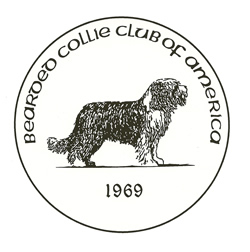With all the unpleasantries behind him, Brad was ready to start afresh and that entailed reclaiming his beloved Beardie, Moragg. While going through an acrimonious divorce, finding new living quarters and getting moved, Brad had elected to leave his year-old Beardie with me, her breeder. Three months had passed before Brad returned and as he was greeted by a bevy of bouncing Beardies, he glanced around with a puzzled expression. “Where’s Moragg?” I stifled a smile before answering, “She’s the one pawing at your leg and wondering why you’re ignoring her.”
“But she’s dark brown.” Right! Moragg had changed from her light and fuzzy puppy coat into a dark red-brown, coarse adult coat in his extended absence. She looked like a different dog. Some Beardies have a way of doing that.
While there are Beardies who ease from puppy coat to adult jacket in such a way that the change hardly registers, there are others who handle the transition in a much more dramatic way. Fr’instance, I have an 18-month-old girl who might best be termed as ‘an arf and arf’ dog. Her front ‘arf’ is coarse, short and silver-grey while the rear ‘arf’ is long, silky, flowing and white in color. She looks like two dissimilar dogs joined in the middle, like something dreamed up by Dr. Seuss. As a puppy, she was jet black (with white markings, of course). Sometime around Month Eight, white splotches appeared down the middle of her back. Over the ensuing months, the white took over until she was almost completely ivory, with the exception of her ears and her hocks. Over the many years I’ve been privileged to spend with Beardies, I’ve had browns and fawns who paled during adolescence but I can’t recall another born black who turned white. Fortunately, the rear ‘arf’ has dark grey hair at the roots so it’s likely she will even out in time. At that point, she might turn out to be silver or charcoal or even black again. She hasn’t let me in on her plans. Small wonder that Beardie folk refer to their dogs’ colors as born black, born brown, born blue or born fawn. When people ask, “What do you call that color?” the best we can tell them is what color they were at birth. After that, it’s all up to the Beardie.
Many years ago, our Beardie club put on a seminar for judges interested in learning more about our breed. We flashed a series of pictures on the screen of a Beardie who started life as bittersweet chocolate, muted to reddish brown, faded even more to tan, then to a champagne shade. Then as he matured, the photos showed him darkening across the shoulders, the sienna finally taking over his whole body coat. At that point, we brought the dog himself as a four-year-old on stage. One of the judges waved a hand. “Do you mean those pictures were all of the same dog?” he queried. Assured that they were indeed, he requested, “May we see those photos again?” Another of the judges was heard to comment it was probably a waste of money for Beardie owners to advertise because the dog would look entirely different by the time the photo came out in print.
Back in the dim and distant 1970s, a judge excused an unfortunate faded fawn youngster from the ring. Not being well versed in the idiosyncrasies of Beardie coloration, the judge decided the juvenile was totally white and penalized her accordingly. It was no doubt an honest mistake as fawns can turn a whiter shade of pale than any other accepted color.
On the other end of the scale, there are a smattering of Beardies who do not feel obligated to change their apparel. One of my current crew is as resolutely ebony-hued as the day he was born some 12 plus years ago. He’s one of the ones we call ‘stay-blacks.’
To the question, what color will she be when she’s finished, the answer is simply that the Beardie is never ‘finished’ but always a work in progress, with the exception of the stay-blacks.
The adult Beardie coat may continue to change shades over its lifetime though staying within the confines of its birth color. For example, a brown won’t turn black but it may cycle through all the shades of brown from mahogany to light tan. I still recall an early Beardie whose adult coat was bands of all the shades of a glorious autumn. Every six months or so, he’d switch to another nuance.
So if you don’t care for your Beardie’s current color… just wait a minute.
— alice bixler, Bearded Collie Club of America, bcca.us




